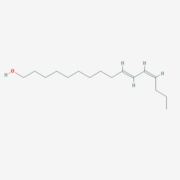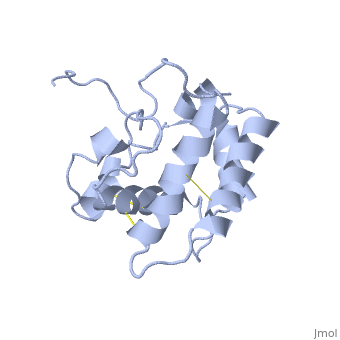Odorant binding protein
From Proteopedia
| Line 46: | Line 46: | ||
BmorPBP has two conformations: The "open form" (A) and the "close form" (B)<ref>DOI: 10.1074/jbc.274.43.30950</ref>. The bombykol and the alpha-helix loacated in the c-terminus of the protein compete for the binding site: when the c-terminus is inside the binding cavity it get's an alpha helix shape, and the protien is in its "close form" (B), wherease in the "open form" (A) the c-terminus is outside of the protein and has no defined secondery sturcture. Binding experiments have shown that the B-form binds 15 times higher than the A-form <ref>doi: 10.1073/pnas.0501447102</ref>, therefore considered to be the carrier of the pheromone. The complex of the A-form and the pheromone, is then considered the form that activates the receptor. | BmorPBP has two conformations: The "open form" (A) and the "close form" (B)<ref>DOI: 10.1074/jbc.274.43.30950</ref>. The bombykol and the alpha-helix loacated in the c-terminus of the protein compete for the binding site: when the c-terminus is inside the binding cavity it get's an alpha helix shape, and the protien is in its "close form" (B), wherease in the "open form" (A) the c-terminus is outside of the protein and has no defined secondery sturcture. Binding experiments have shown that the B-form binds 15 times higher than the A-form <ref>doi: 10.1073/pnas.0501447102</ref>, therefore considered to be the carrier of the pheromone. The complex of the A-form and the pheromone, is then considered the form that activates the receptor. | ||
| - | In short, the B-form (c-terminus outside the cavity) occurse only at neutral pH and in the presence of the ligand. The A-form (c-terminus inside the cavity) occurs at both low and nuetral pH, yet at the latter only in the absence of ligand. | + | The <scene name='68/683383/1dqe-1gm0/2'>transition between the two conforamtion</scene> is both pH and ligand dependent <ref>doi: 10.1073?pnas.251532998</ref><ref>DOI: 10.1016/j.bbrc.2005.07.176</ref><ref>doi: 10.1073/pnas.1317706110</ref>. In short, the B-form (c-terminus outside the cavity) occurse only at neutral pH and in the presence of the ligand. The A-form (c-terminus inside the cavity) occurs at both low and nuetral pH, yet at the latter only in the absence of ligand. Therfore, in neutarl pH when the ligand is binding to the protein in its A-form, the complex formation causes a change in conforamtion to the B-form. However, both A and B forms are equaly distributed in the lymph. |
| + | {{Button Toggle AnimationOnPause}} | ||
| - | |||
| - | The transition between the two conformation is taking place between 6-5 pH. | ||
'''Conformation transition mechanism:''' | '''Conformation transition mechanism:''' | ||
| - | The c-terminus of the protein bears mostly | + | The c-terminus of the protein bears mostly nonpolar amino acids. Yet on the surface of the helix there are three exceptional amino acids: Asp-132, Glu-137, and Glu-141, which are conserved in moth PBP <ref>doi: 10.1016/j.bbrc.2005.07.176</ref>. Of these, residues <scene name='68/683383/Bombykol_ligand_in_2p71/2'>Asp-132</scene> (and Glu-141, if present) triggers the formation of the alpha-helix upon protonation at low pH. This causes the ejacullation of the ligand from the binding pocket, which is replaced by the formated alpha helix<ref>doi: 10.1016/j.bbrc</ref>. |
| - | The <scene name='68/683383/1dqe-1gm0/2'>transition between the two conforamtion</scene> is both pH and ligand dependent <ref>doi: 10.1073?pnas.251532998</ref><ref>DOI: 10.1016/j.bbrc.2005.07.176</ref><ref>doi: 10.1073/pnas.1317706110</ref>. | ||
| - | |||
| - | {{Button Toggle AnimationOnPause}} | ||
<scene name='68/683383/Bombykol/3'>A form, with ligand</scene> | <scene name='68/683383/Bombykol/3'>A form, with ligand</scene> | ||
Revision as of 13:44, 11 January 2015
Contents |
Introduction
Odorant-binding protein (OBP) are soluble proteins which involve in the processes of odorant detection in the olfactory sensilla.
The first OBP that was identified is Bovine odorant binding protein, that was isolated from a cow's mucus ref. Though functunaly same, vertebrates and insects OBP have different origin and stucture. OBPs are important for insect olfaction. For instance, OBP76a (LUSH) in the fly Drosophila melanogaster is required for the detection of the pheromone vaccenyl acetate [Ha and Smith, 2006; Xu et al., 2005] and has been proven to adopt a conformation that activates the odorant receptor [Laughlin et al., 2008].

OBP in insects
OBP Function
Despite five decades of intensive research, the exact roles of OBP and the mechanism by which the odorant receptor (OR) is activated are still in dispute [1][2].
A few functions have been suggested for OBP: 1. Solubelizing the odorant molecule and its transportation in the sensillar lymph.
2. Protecting the odorant molecule from the odorant degrading enzymes, in the sensillar lymph.
3. Activating of the odorant receptor on the dendrite membrane, by the odorant-OBP complex.
4. Mediating the deactivation of the odorant molecule after the activation of the receptor.
5. An organic anion (the protein has 9 negative charges).
Of all, the first role of OBP as an odorant solubilizer and carrier is generally accepted.
In order to explain the structure and function of these fascinating proteins, this page will further focus on a particular OBP - the well investigated Bombyx mori PBP: BmorPBP.
Bombyx mori BmorPBP (lets talk about sex..)
| |||||||||||
See also
References
Proteopedia Page Contributors and Editors (what is this?)
Nurit Eliash, Michal Harel, Joel L. Sussman, Alexander Berchansky, Jaime Prilusky



